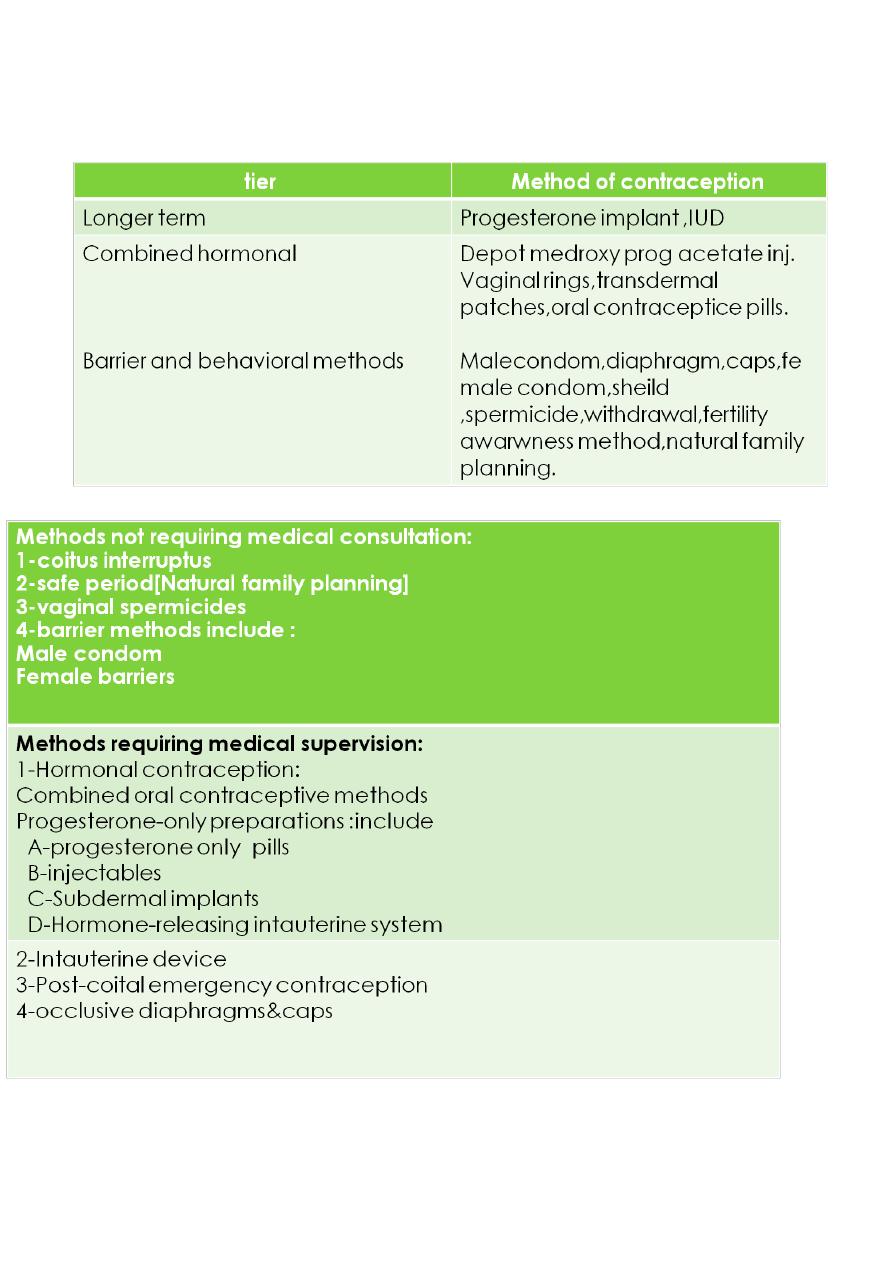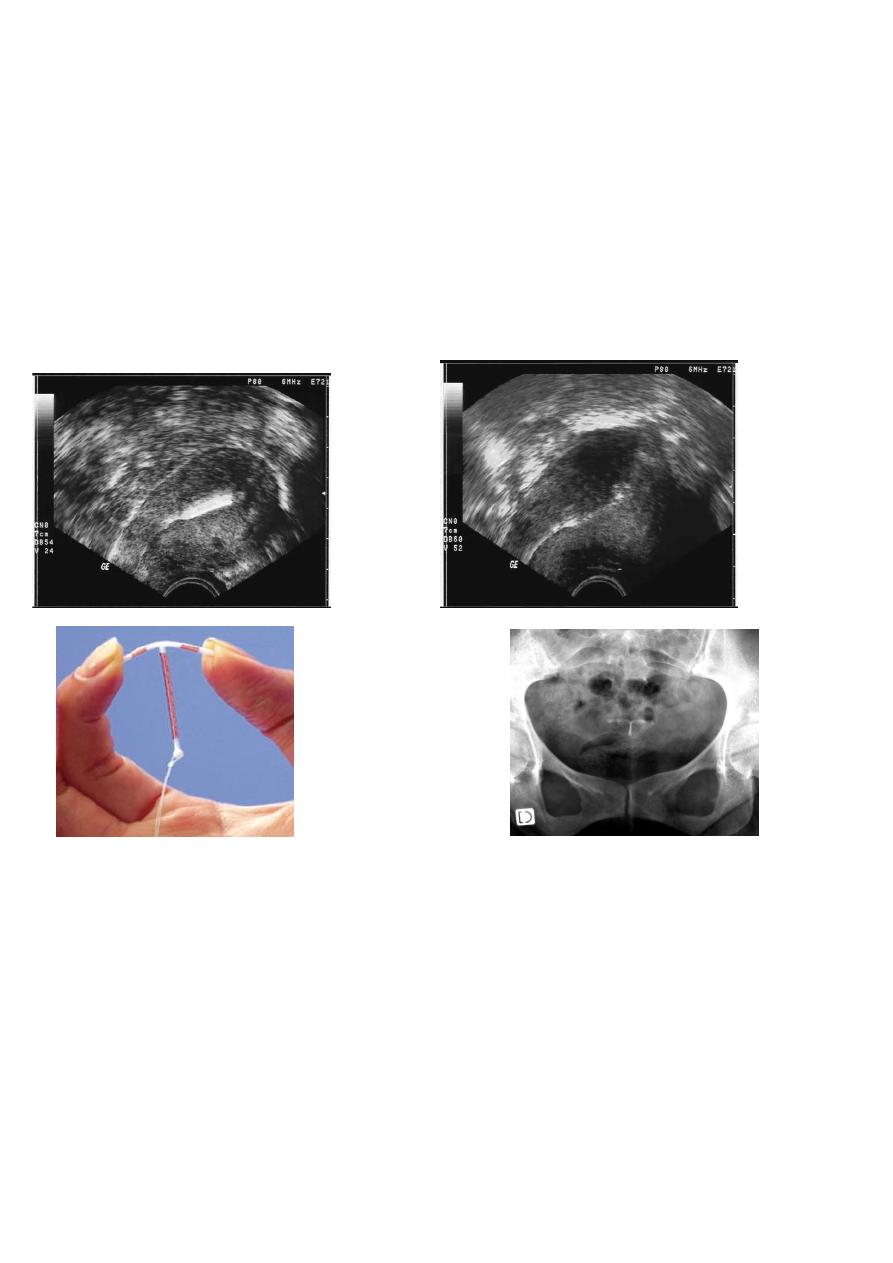
1
Fifth stage
Gynecology
Lec-3
د.سراب
30/12/2015
FERTILITY CONTROL AND CONTRACEPTION
Family planning plays a critical role in promoting personal health of the women ,optimizing
both maternal and fetal well being
Every year 600000 women die worldwide from pregnancy and pregnancy related causes.
In developing countries the estimated average annual risk of dying from causes related to
pregnancy and childbirth may be about 185 per 100,000 women not using contraception
3 million women suffer significant permanent disabilities.
Many STD can be prevented by contraception. (HIV )infection.
There is no one method that will suit everyone, and individuals will use different types of
contraception at different stages in their lives.
the ideal contraceptive method should:
• Highly effective
• No side effects
• Cheap
• Rapidly reversible
• Widespread availability
• Acceptable to all cultures and religions
• Easily distributed
• can be administrated by non- health care personnel.
As effective as modern contraceptives have been, they have not yet achieved their full
potential.
Many unintended pregnancies still occur in a woman who are using contraception but are
not using their chosen method correctly.
Virtually all methods of contraception occasionally fail and some are much more effective
than others.

2
Failure rates are traditionally expressed as the number of failures per 100 woman-years
(HwY ), i.e. the number of pregnancies if 100 women were to use the method for1 year.
Failure rates for some methods vary considerably, largely because of the potential for
failure caused By imperfect use (user failure) rather than an Intrinsic.
Contraceptive failure rate comparing typical use and perfect use:

3
Classification:
Combined oral contraceptive methods are grouped into tiers depending on their efficacy
with typical use.
Perminant methods[sterilization]
Female tubal occlusion
Male vasectomy

4
Combined oral contraceptive pills(the pill)
first licensed in the UK in 1961. It contains a combination of two hormones: a synthetic
oestrogen and progestogen available as once daily pill.
Since COC was first introduced, the doses of both oestrogen and progestogen have been
reduced dramatically, which has considerably improved its safety profile..
Combined oral contraception is easy to use and offers a very high degree of protection
against pregnancy, with many other beneficial effects. It is mainly used by young, healthy
Formulation:
Combined oral contraceptive pills contains both:
1-Synthetic Estrogen (Ethinyl estradiol mostly):
The dose of oestrogen varies from 50 to 15 μg.
2-Synthetic progestogens
Either one of these :
*First generation(e.g. norethindrone).
*Second generation progestins (e.g. levonorgestrel) .
*Third generation series including gestodene, desogestrel and norgestimate
Monophasic pills contain standard daily dosages of oestrogen and progestogen.
Biphasic or triphasic preparations have two or three incremental variations in hormone
dose.
Current thinking is that biphasic and triphasic preparations are more complicated for
women to use and have few real advantages.
For maximum effectiveness, COC Most brands contain 21 pills; one pill to be taken daily,
followed by a 7-day pill-free interval. There are also some every-day (ED) preparations that
Include seven placebo pills that are taken instead of having a pill-free interval should always
be taken regularly at roughly the same time each day. Other are for extended cycle use to
eliminate or minimize the number of scheduled bleeding episode induced by placebo
pills.this scheduled bleeding is not medically indicated but desired by some women for
personal reason.

5
Preparation
1.low-dose pills containing 30μg of ethinyl estradiol
2.high-dose pills contain contain 50 μg estrogen.
Higher dosages of oestrogen are strongly linked to increased risks of both arterial and
venous thrombosis
3.Yasmin
contains ethinyl estradiol and drospirenone.
Drospirenone has antimineralocorticoid activity. It can help prevent bloating, weight
gain, and hypertension, but it can increase serum potassium.
Yasmin is contraindicated in patients at risk for hyperkalemia and should not be combined
with other drugs that can increase potassium
Mode of action
Combined oral contraception acts both centrally And peri pherally .
•centrally Inhibition of ovulation is by far the most important effect. Both oestrogen and
progestogen suppress the release of pituitary FSH and LH, which prevents follicular
development within the ovary and therefore ovulation .
• Peripheral effects include
- Making endomtrium atrophic and hostile to an implanting embryo
- altering cervical mucus to prevent sperm ascending into the uterine cavity.
Contraindication:
absolute:
1• Circulatory diseases:
- iscihaemic heart disease- cerebrovascular accident
- significant hypertension
- arterial or venous thrombosis

6
- any acquired or inherited pro-thrombotic tendency
- any Significant risk factors for cardiovascularpisease
2• Acute or severe liver disease
3• Oestrogen-dependent neoplasms, particularly breast
cancer
4.Breastfeeding <6 weeks post-partum
5.Smoking ≥15 cigarettes/day and age ≥35
6.Focal migraine
Relative contraindications
• Generalized migraine
• Long-term immobilization
• Irregular vaglinal bleeding (until a diagnosis has been made)
• Less severe risk factors for cardiovascular disease,e.g. obesity, heavy smoking, diabetes
Side effect:
1-Venous thromboembolism:
VTE is the major measurable risk otherwise the combined oral contraceptive pills are
very safe.
Oestrogens alter blood clotting and coagulation in a way that induces a pro-thrombotic
tendency, although the exact mechanism of this is poorly understood. The higher the dose
of oestrogen within COc, the greater the risk of venous thromboembolism (VTE)... Type of
progestogen also affects the risk of VTE, with users of COC containing third-generation
progestogens being twice as likely to sustain a VTE.
The risks of VTE are:
• 5 per 100 000 for normal population,
•15 per 100 000 for users of 2
nd
generation.

7
•30 per 100 000 for users of 3
rd
generation.
•60 per 100 000 for pregnant women.
2-Arterial disease
*risk of hypertention:
1 per cent of COC users will become significantly hypertensive and they should be advised
to stop taking COC
*risk of myocardial infarction and thrombotic
stroke :in young, healthy women using low-dose COC is extremely small.
Cigarette smoking will, however, increase the arterial risk, and any woman who smokes
must be advised to stop COC at the age of 30years.
3-Mortality
There is increased mortality in women using the pills over women not using it, related to
age&smoking habits.
Death is most often the result of pulmonary embolism,cerebral or coronary thrombosis.
Women who are under 35 years, do not Smoke nor have hypertention or diabetes have no
exess mortality otherwise women over 35 years ,women who Smoke or have hypertention
there is excess mortality .
4.Carcinogenic effect:
Breast cancer
Most data do show a slight increase in the risk of developing breast cancer among current
COC users (relative risk around l. 24).
This is not of great significance to young women, as the background rate of breast cancer is
very low at their age. However, for a woman in their forties, these are more relevant data,
as the background rate of breast cancer is Higher, but beyond 10 years after stopping coc
there was no increase in breast cancer risk for former coc users.

8
Cervical cancer
More than five years of pill use may be associated with small increase risk of cervical
carcinoma.
Liver cancer
Benign hepatic adenoma is a rare consequence of COC use
Minor side effects
CNS: Depression,Headaches, Loss of libido
Gastrointestinal: Nausea and vomiting, Weight gain, Bloatedness, Gall-stones, Cholestatic
jaundice
Genitourinary system: Cystitis , Irregular bleeding, Vaginal discharge, : Growth of fibroids
Breast: Breast pain, Increased risk ofbreast cancer
miscellaneous: Chloasma (facial pigmentation),Leg cramps
Method of use
The patient begins taking the pills on the first day of menstrual cycle then in the next cycles
they are administered in fifth day of the cycle and continue for 21 days, each day at the
same time, then discontinued for 7 days to allow for withdrawal bleeding that mimics the
normal menstrual cycle which occur after 3-5 days from stopping pills
If pills are missed ???? How late are you???
Less than 12 hours late:
Don't worry. Just take the delayed pill at once, and further pills as usual
More than 12 hours late:
• Take the most recently delayed pill now|
• Use extra precautions (condom, for instance) for the next 7 days
Drug interaction
*This can occur with enzyme-inducing agents Such as some anti-epileptic drugs increase
activity of hepatic enzyme so reduce efficacy of COC.Higher dose oestrogen coc containing
50 Mg ethinyl oestradiol may need to be prescribed

9
*Some broad-spectrum antibiotics Ampicillin, Amoxicillin, Tetracycline , Neomycin can alter
intestinal absorption of COC and reduce its efficacy. Additional contraceptive measures
should therefore be recommended during antibiotic therapy and for 1 week thereafter.
*Steroids ,Ascorbic acid (Vitamin C) and acetaminophen may elevate plasma ethinyl
estradiol so increase its efficacy.
Positive health benefits
*COC users generally have light, pain -free, regular bleed and therefore COC can be used to
treat heavy or painful periods ( menorrhagia & dysmenorrhea )
*It will also improve premenstrual syndrome(PMS)
*reduce the risk of pelvic inflammatory disease(PID).
*decreased incidence of benign breast lump.
*decrease number of functional ovarian cyst.
*less endometriosis.
*COC offers long-term protection.
against both ovarian and endometrial cancers.
*It can also be used as a treatment for acne.
Combined oestrogen and progesterone vaginal ring
It is soft ring that a woman can insert into vagina; and the Women who use Ring leave the
ring in place for 3 weeks during a month. During the 4th week, the ring is removed for 7
days. A new ring is used for each cycle.
Combined hormonal patches
A contraceptive transdermal patch containing Oestrogen and progestogen has been
Developed and releases norelgestromin 150 Mg and ethinylestradiol 20 Mg per 24 hours.
Patches are applied weekly for 3 weeks, after which there is a patch-free week.
Contraceptive patches have the same risks and benefits as COC and, although they are
relatively more expensive, may have better compliance.

11
Progesterone only contraception:
All other types of hormonal contraception in current use in the world are progestogen -only
and share many similar features in terms of mode of action and side effects. Because they
do not contain oestrogen, they are extremely safe & can be used if woman has
cardiovascular risk factors.
The dose of progestogen within them varies from very low to high The current methods of
progestogen-only contraception are
• progestogen-only pill, or 'mini-pill'
• subdermal implant Implanon®
• injectables.
• hormone-releasing intrauterine system
Mechanism of action
1-peripheral effects:
*local effect on cervical mucus making it hostile to ascending sperm.
*Local effect on the endometrium making it thin & atrophic thereby preventing
implantation
*Progestin use also causes decreased tubal and endometrial motility.
2-central effects
Higher dose progestogen-only methods can act centrally & inhibit ovulation .
Side effects
Menstrual disturbances either irregular vaginal bleeding or amenorrhea. Functional ovarian
cyst
Increase risk of ectopic pregnancy :this has not been confirmed,although it is probably that
POP protect much more effectively against intrauterine than ectopic pregnancy.

11
Progestogen-only pills
The progestogen-only pill (POP) is ideal for Women who like the convenience of pill taking
but cannot take COC. Although thefailure rate of the POP is greater than that Of COC , it is
ideal for women at times of lower fertility.
If the POP fails, there is a slightly higher risk of ectopic pregnancy they contain
*the second-generation progestogen norethisterone or norgestrel (or their derivatives)
*or the third-generation progestogen desogestrel.
The POP is taken every day without a break Particular indications for the POP include:
• breastfeeding
• older age
• cardiovascular risk factors
• diabetes.
Injectable progestogens
Two injectable progestogens are marketed.
• Depot medroxyprogesterone acetate 150 mg
(Depo-Provera or DMPA) which lasts around 12-13 weeks .
• Norethisterone enanthate 200 mg (Noristerat) which only lasts for 8 weeks and is not
nearly so widely used.
Depo-Provera is a highly effective method Of contraception and it is given by deep
intramuscular injection Most women who use it develop very light or absent menstruation.
Depo-Provera will improve
PMS and can be used to treat menstrual problems such as painful or heavy periods.
It is particularly useful for women who have difficulty remembering to take a pill
Particular side effects of Depo-Provera
• weight gain of around 3 kg in the first year,
• delay in return of fertility - it may take Around 6 months longer to conceive compared to
a woman who stops COC,

12
• persistent menstrual irregularity ,irregular vaginal bleeding may occur or amenorrhea in
prolonged use of this injection
• very long-term use may slightly increase the Risk of osteoporosis (because of low
oestrogen levels)
Particular indications for depo provera
-contraindication to estrogen
-Following rubella vaccination in peurperium.
-Husband waiting for effect of vasectomy.
-Mental retarded women. .
-Breast-feeding.
-population control in developing countries.
Subdermal implants
Implanon consists of a single silastic rod that is inserted subdermally under local
anaesthetic into the upper arm. It releases the progestogen etonogestrel 25-70 Mg daily
(the dose released decreases with time), which is metabolized to the Third-generation
progestogen desogestrel.
Implanon was introduced into the UK in the late 1990s.
Other type of implant is the six-rod implant, Norplant, which is withdrawn from the market
It lasts for 3 years and thereafter can be easily removed or a further implant inserted.
Implanon is particularly useful for women who have difficulty remembering to take a pill
and Who want highly effective long-term contraception. There is a rapid return of fertility
when it is removed.
Intrauterine device
IUDs can be classified as either:
Medicated,
copper-bearing T380A(copper T IUD)
levonorgestrel hormone-releasing (LNG-IUD)

13
Unmedicated, or inert
The majority of the IUDs now widely used are copper-bearing. This IUD provides excellent
pregnancy protection that is convenient and rapidly reversible.
1
st
year failure rates are 0.7% and cumulative
10- to 12-year pregnancy rate are 1.4% to 1.9%. most women are candidate for IUD use
including those with serious medical problems as Hypertension, morbid obesity, diabetes,
stroke ,MI , and even cancer.
Mechanism of action of copper T IUD
Induce inflammatory reaction within the endometrium make the cavity and tube fluid that
is toxic to the sperm ,oocyte and the embryo,
Copper ions released from copper IUD reach a level in the uterine cavity fluid that is toxic to
the sperm oocyte and embryo.
It appear that IUD mainly interfere with the fertilization, that’s only few sperms reaching
the fallopian tube by cervical mucos hostility and by interfering with sperm motility,and
affecting tubal motility, and if reaching are incapable of fertilization, even the oocyte is
incapabale to be fertilized.
IUD interfere with sperm motility , oocyte capability of fertilization and implantation.
Complication of IUD:
Bleeding and pain
Increased menstrual bleeding, often with pain, is the most common problem of
IUD use and the most common medical reason for removing lUDs
Older women and women with children generally have lower rates of removal due
to bleeding and pain.
Unlike other IUDs, hormone-releasing devices decrease menstrual blood flow or,
may even stop menstruation altogether
With all IUDs, abnormal bleeding and pain may be due not to the IUD itself but to
pelvic inflammatory disease (PID), ectopic pregnancy, malignancy, or other
conditions

14
IUD use has not been proved to induce clinical anemia
In a study of the TCu-380Ag carried out in several developing countries and the
US, the proportion of women with anemia rose only from 24% to 25.4% during
four years of use
Infection(PID):
Many studies have confirmed that the risk of infection and infertility among IUD users is
very low (2004). However, studies also indicate that the insertion process and not the IUD
or its strings, pose the temporary risk of infection.
Good infection prevention procedures should be practiced.
Antibiotic prophylaxis should not be used routinely prior to insertion.
The risk of infection following IUD insertion returns to a very low or normal level after 20
days (1992).
Perforation
Perforation of the uterus occurs when the IUD, the inserter tube, the sound, or another
gynecological instrument used during insertion pierces the uterine muscle wall, most often
at the fundus, or top of the uterus
Careful insertion technique can prevent most perforations
Perforations may go unnoticed at the time of insertion
Over time lUDs may become embedded in the uterine wall without perforating it
Expulsion
After IUD insertion, uterine contractions can push the device downward, causing partial or
complete expulsion
Most expulsions occur in the first year and especially the first three months after insertion
Younger women and women who have never been pregnant or have never had children
are more likely to expel their lUDs
Women who had painful menstruation or abnormally large menstrual flows were more
likely to expel copper-T IUDs

15
Correct insertion, with the IUD placed up to the fundus, is thought to reduce the chances
of expulsion
Intrauterine pregnancy
If pregnancy does occur, potentially severe complications can result. Medical attention is
always needed
Spontaneous abortion is the most frequent complication of pregnancy with an IUD in place
the IUD should be removed as soon as pregnancy is confirmed
An IUD left in place during pregnancy also increases the risk of premature delivery. It does
not increase the risk of other complications-birth defects, genetic abnormalities, or molar
pregnancy
Ectopic pregnancy
Mounting evidence indicates that most lUDs help to protect against ectopic
pregnancy while they are in use
IUD users were half as likely to experience ectopic pregnancies as women using no
contraception
A recent analysis of randomized trials found that second-generation copper lUDs and
the LNG-20 reduce ectopic pregnancy rates to 10% of the level among women using
no contraception
lUDs provide less protection against ectopic pregnancy than consistently used oral
contraceptives or barrier methods
Any pregnancy in an IUD user is uncommon, however. The ectopic pregnancy in an
IUD user is rare
TCu-380A and MLCu-375, have the lowest ectopic pregnancy rates – 0.25 and close
to 0 per 1,000 woman years
Clinical implications:
Women using lUDs should be told about the signs of ectopic pregnancy

16
If an IUD user conceives or shows signs of pregnancy, health care providers should
always look for ectopic pregnancy
A woman who has had an ectopic pregnancy can use an IUD
There is no evidence that IUDs cause any type of cancer among IUD users. WHO and
US researchers have/estimated about one to two deaths per 100,000 IUD users per
year from infection, ectopic pregnancy, or second-trimester septic abortion.
The IUD is one of the safest family planning methods, according to estimates of
annual death rates among US women using various family planning methods or no
method.
Containdication:
Nulliparity and infertility: higher rate of expulsion and discomfort,,,infertility ???
Active infection,,if IUD Increased risk of actinomyces which is recovered after
removal and re insertion.
Uterine anomalies increase risk of expulsion and perforation.
gynecologic malignancy.
genital bleeding of unknown cause.
gestational trophoblastic disease.
Levonorgestrel releasing IUD
• The LNG IUS is made of flexible plastic
• The LNG IUS contains a progestin hormone called levonorgestrel which has been
used in birth control pills since the 1970s
• The safety of levonorgestrel has been proven by clinical use also in sub-dermal
implants and intrauterine systems since decades
in every country LNG-IUD is approved for contracepttion with an effect comparable to
sterilization with an ability for regret, and is approved for treatment of heavy prolonged
menstrual bleeding ,and is effective as endometrial ablation.

17
LNG IUS MECHANISMS OF ACTION
• Thickens cervical mucus
• Inhibits sperm function in uterus
• Reduces monthly growth of the lining of the uterus making periods lighter and
shorter; there is no evidence that LNG IUS has any impact on implantation
• LNG IUS can also lessen menstrual blood loss in women who have heavy menstrual
flow
Treatment of heavy menstrual bleeding
Use of LNG IUS makes periods lighter, shorter and less painful
Over 12 months, blood loss reduced by 80-96% in women with menorrhagia
Clinical improvement in associated anemia:
Hemoglobin levels rise 1.8g/L in one year of use with LNG IUS, compared to a decrease
of 1.2g/L with Copper-T.
Irregular bleeding or spotting common in first 3-6 months; 20% with amenorrhea at 12
months. Sometimes the amenorrhea rate can be higher than 20% e.g. up to 50% at 12 and
24 months of use.
What are the most common side-effects of the LNG IUS?
10+ in every 100 women are likely
to experience the following:
• Headache
• Abdominal/ pelvic pain
• Bleeding changes
• Vulvovaginitis (inflammation of the external genital organs or vagina)
• Genital discharge
1 to 10 in every 100 women are likely to experience the following:
• Depression
• Migraine
• Nausea
• Acne
• Hirsutism (excessive body hair)
• Back pain

18
These side effects are common among OC Pill users as well.
LNG-and risk of ectopic pregnancy
• It is very rare to become pregnant while using LNG IUS
• However, if you become pregnant while using LNG IUS, the risk having an ectopic
(extra-uterine) pregnancy is relatively increased
• About 1 in a 1000 women correctly using LNG IUS have an ectopic pregnancy per
year. This rate is lower than that among women not using any contraception (about 3
to 5 in a 1000 women per year)
• Woman who have already had an extra-uterine pregnancy, pelvic surgery or pelvic
infection carry a higher risk of experiencing an ectopic pregnancy
Emergency contraception
Post-coital contraception is any drug or device used prevent pregnancy after unprotected
intercourse
There are two types of emergency contraception[EC]
A-hormonal emergency contraception
1-Combined oestrogen&progesterone[CEP]:
Combination of 100 microgram ethinyl estradiol &0.5 mg levonorgestrel is taken twice the
two doses being 12 hours apart & started within 72 hours of unprotected intercourse
Nausea & vomiting are common side effects.
The precise mechanism of action is not known but probably involves disruption of ovulation
or corpus luteal function depending on the time in the cycle when hormonal EC is taken so
it inhibit ovulation or interfere with implantation.
2-Levonorgestrel alone:
Levonorgestrel 0.75 mg taken twice with two doses separated by 12 hours ,it may be more
effective & better tolerated
It has to be taken within 72 hours of an episode of unprotected intercourse and is more
effective the earlier it is taken

19
B -intrauterine device
A copper-bearing IUD is highly effective post-coital contraceptive with failure rate less than
1%,used up to five days after the estimated day of ovulation.It prevent implantation &the
copper exerts an embryotoxic effect
The hormone-releasing IUS has not been shown to be effective for EC and should not be
used in this situation
Ultrasound imaging
Copper IUD LNG IUD
X ray
with LNG IUD
